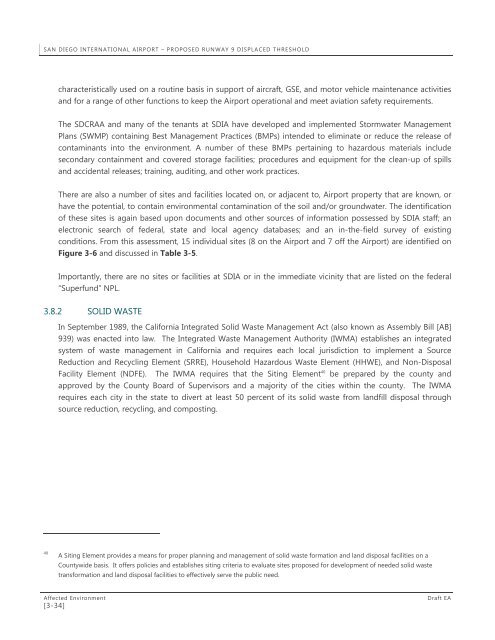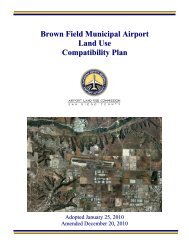Draft EA - San Diego International Airport
Draft EA - San Diego International Airport
Draft EA - San Diego International Airport
Create successful ePaper yourself
Turn your PDF publications into a flip-book with our unique Google optimized e-Paper software.
SAN DIEGO INTERNATIONAL AIRPORT – PROPOSED RUNWAY 9 DISPLACED THRESHOLD<br />
characteristically used on a routine basis in support of aircraft, GSE, and motor vehicle maintenance activities<br />
and for a range of other functions to keep the <strong>Airport</strong> operational and meet aviation safety requirements.<br />
The SDCRAA and many of the tenants at SDIA have developed and implemented Stormwater Management<br />
Plans (SWMP) containing Best Management Practices (BMPs) intended to eliminate or reduce the release of<br />
contaminants into the environment. A number of these BMPs pertaining to hazardous materials include<br />
secondary containment and covered storage facilities; procedures and equipment for the clean-up of spills<br />
and accidental releases; training, auditing, and other work practices.<br />
There are also a number of sites and facilities located on, or adjacent to, <strong>Airport</strong> property that are known, or<br />
have the potential, to contain environmental contamination of the soil and/or groundwater. The identification<br />
of these sites is again based upon documents and other sources of information possessed by SDIA staff; an<br />
electronic search of federal, state and local agency databases; and an in-the-field survey of existing<br />
conditions. From this assessment, 15 individual sites (8 on the <strong>Airport</strong> and 7 off the <strong>Airport</strong>) are identified on<br />
Figure 3-6 and discussed in Table 3-5.<br />
Importantly, there are no sites or facilities at SDIA or in the immediate vicinity that are listed on the federal<br />
“Superfund” NPL.<br />
3.8.2 SOLID WASTE<br />
In September 1989, the California Integrated Solid Waste Management Act (also known as Assembly Bill [AB]<br />
939) was enacted into law. The Integrated Waste Management Authority (IWMA) establishes an integrated<br />
system of waste management in California and requires each local jurisdiction to implement a Source<br />
Reduction and Recycling Element (SRRE), Household Hazardous Waste Element (HHWE), and Non-Disposal<br />
Facility Element (NDFE). The IWMA requires that the Siting Element 40<br />
be prepared by the county and<br />
approved by the County Board of Supervisors and a majority of the cities within the county. The IWMA<br />
requires each city in the state to divert at least 50 percent of its solid waste from landfill disposal through<br />
source reduction, recycling, and composting.<br />
40<br />
A Siting Element provides a means for proper planning and management of solid waste formation and land disposal facilities on a<br />
Countywide basis. It offers policies and establishes siting criteria to evaluate sites proposed for development of needed solid waste<br />
transformation and land disposal facilities to effectively serve the public need.<br />
Affected Environment<br />
[3-34]<br />
<strong>Draft</strong> <strong>EA</strong>
















